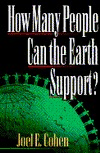
How Many People Can the Earth Support? PDF
Preview How Many People Can the Earth Support?
7i Available IN Paperback For Fall 1996 Classes (LSBNO 393-31495-2) $14.95 N ^> > y \ \ ISBN0-393-03862-9 $30.00USA $39.99CAN. How Many People Can the Earth Support? JOELE.CQHEN Past attempts —to answer this question have ranged widely from l—ess than 1 billion to more than 1,000 billion one sign that there is no single right answer. More than halfofthe estimates, however, fall within a much nar- rower range: between 4 billion and 16 billion. In any case, with the world population now at 5.7 billion, andincreasing byapproximately90 million peryear,we have clearlyentered a zone where limits on the human carrying capacity of the Earth have been anticipated, and may well beencountered. In this penetrating analysis of one ofthe most crucial questions of our time, a leading scholar in the field reviews the historyofworld population growth and gives a refreshingly frank appraisal of what little can be known about its fiature. In the process, he offers the most comprehensive account yet available of how various people have tried to estimate the planet's human carrying capacity. Few con- temporary writers have addressed the issue of world population growth in such a balanced, objective way, without using it as a pretext to advanceapriorpolitical agenda. This book shows that the apparendy simple How question posed by its tide is incomplete: many people can the Earth support, given what kinds ofeconomies and technologies. At > what levels of material well-being.^ Living in what physical, chemical, and biological en- vironments.^ And with what cultural values, whatsocial,political, andlegalinstitutions.> The answers to these questions, the author argues, will be determined not only by natural constraints, which are still not fiilly under- stood, but also by human choices. Such — choices about everything from food and the environmen—t to styles oflife and other dearly held values will in turn influence what na- tural constraints will matter. And as these human choices change in time, so will our notions of the planet's human carrying capacity. (continuedonbackflap) Jacketdesignandillustration byKevinONeill. 11-95 r^ HOW MANY PEOPLE CAN THE EARTH SUPPORT? Other books byJOEL E. COHEN A Model of Simple Competition Casual Groups of Monkeys and Men: Stochastic Models of Elemental Social Systems Food Webs and Niche Space Random Matrices and Their Applications (edited with Harry Kesten and Charles M. Newman) Community Food Webs: Data and Theory (with Frederic Briand and Charles M. Newman) Absolute Zero Gravity (with Betsy Devine) Mutualism and Community Organization: Behavioral, Theoretical and Food Web Approaches (edited with Hiroya Kawanahe and Keiji Iwasaki) / How Many People I Can the Earth Support? COHEN JOEL E. ^ WW- NORTON & COMPANY New York London • Copyright © 1995 byJoel E. Cohen All rights reserved Printed in the United States ofAmerica The text ofthis bookis composed in Bembo with the display set in Bembo Composition and manufacturing by The Maple-Vail Book Manufacturing Group. Book design byJacques Chazaud Library ofCongress Cataloging-in-Publication Data Cohen,Joel E. How many people can the earth support? /Joel E. Cohen. p. cm. Includes bibliographical references (p—. 481) and index. 1. Population density. 2. Population Economic aspects. 3. Population forecasting. I. Title. HB1953.C64 1995 304.6'1—dc20 95-6133 ISBN 0-393-03862-9 W. W. Norton & Company, Inc., 500 Fifth Avenue, New York, N.Y. 10110 W. W. Norton & Company Ltd., 10 Coptic Street, London WCIA IPU 234567890 i To my wife Audrey, to our children Zoe and Adam, and to our children's godfather William T. Golden I 14
